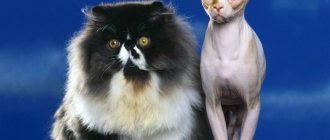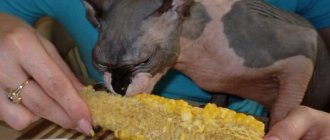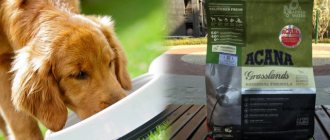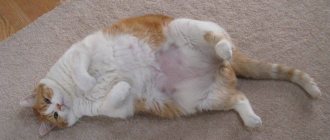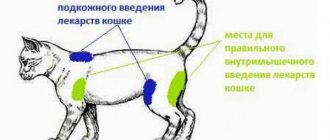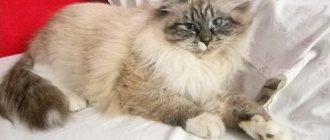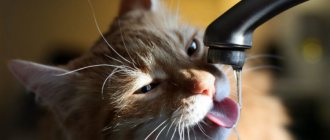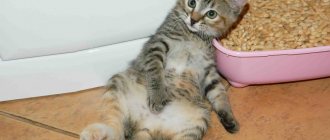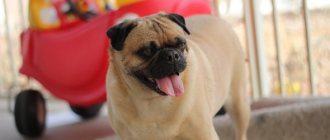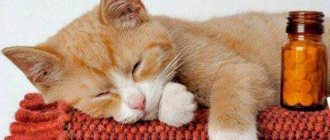Optimally suitable menu
Natural nutrition
How much and how to feed a cat depends not only on the age and physiological state of the animal, but also on the energy value of the food or natural products from which Murka’s diet is based. Typically, the average cat for every kilogram of weight should receive:
- at least 10 g of protein,
- up to 2 g fat,
- up to 3 g of carbohydrates (of which up to 0.4 g should be fiber)
- and various vitamin and mineral baits and supplements.
How much food a cat needs per day can be seen in the table (when feeding natural products - g/day):
| Product type | Adult cats | Kittens | ||||
| up to 1 month | 1-3 months | 3-6 months | 6 months and > | |||
| Meat and meat by-products | 80-120 | 8-10 | 10-60 | 60-80 | 80-100 | |
| Fish | 80-100 | 6-8 | 8-50 | 50-60 | 60-80 | |
| Milk | 100-200 | 20-30 | 30-100 | 100-130 | 130-150 | |
| Cottage cheese | 30-50 | 3,5 | 5-10 | 10-15 | 15-20 | |
| Groats | 50-80 | 10-20 | 20-50 | 50-70 | 70-80 | |
| Vegetables | 30-40 | 10-15 | 15-20 | 20-30 | 30-40 | |
| Animal fat | 5-8 | 1 | 1-2 | 3 | 3-4 | |
| Flour | meat and bone | 10-15 | — | 5-8 | 8-10 | 10-12 |
| fish | 8-12 | — | — | 3-5 | 3-5 | |
| bone | 8-10 | 1-2 | 2-5 | 5-7 | 7-8 | |
| Fish fat | 1,3 | 0,5 | 0,5-1 | 1-1,5 | 1-1,5 | |
| Chicken eggs, pcs. | 1-2 per week | |||||
Depending on the general needs, cat owners can create the menu for their pets themselves.
A few simple recipes for nutritious feeding:
- 1 recipe . Cook separately 2 kg of meat (beef, poultry, rabbit, turkey), 200 g of buckwheat or rice, up to 500 g of vegetables (turnips, broccoli, bell peppers, carrots). Grind everything through a meat grinder, season with olive oil (no more than 2 tablespoons) and a small amount of weak broth after cooking the meat. The resulting mixture is divided into portions (by weight it is good to correspond to 1 feeding) and frozen. This mixture is enough to feed an adult cat weighing up to 5 kg for a week.
- 2 recipe . Raw 150-200 g of vegetables, 1 kg of raw chicken fillet and up to 150 g of boiled rice are passed through a meat grinder. Meatballs are formed, boiled in boiling water for 10-15 minutes, cooled and frozen.
- 3 recipe . Cut into medium-sized pieces: 700 poultry or beef (50/50 is possible), 200 g chicken or beef hearts (an excellent source of taurine), up to 100 g liver (no more). Everything is filled with ½ cup of natural fiber and seasoned with 2 chicken yolks. The mixture is frozen in portions. Feed daily according to natural feeding standards. Be sure to defrost before serving.
You can create different quantities of such recipes yourself. In addition to the listed products, your diet should contain 20-30 grams of fermented milk products (kefir, fermented baked milk, low-fat cottage cheese) every day. Vitamin and mineral supplements can and should be added to the composition.
How much natural food should a cat eat? It should be no more than 7-7.5% of the cat’s total body weight.
| Cat weight | The daily portion of natural food should not exceed |
| With a cat weighing 4 kg | up to 300 g. |
| for pregnant | up to 350 g. |
| old cats | up to 200 g |
| kittens | 50-100 g. |
Of course, the figure is approximate and can vary in one direction or another, depending on the physiological state of the animal (illness or recovery from it, pregnancy, feeding kittens with breast milk, old cats, etc.).
When feeding natural products, the amount of water the cat drinks is from 70 to 80 ml .
Feeding dry food
How much dry food should I give my cat? Typically, on the packaging, each manufacturer always writes the daily consumption rate, which should be followed. If there is no information (for example, the food was purchased in bulk without packaging), then you should roughly adhere to the following scheme (taking into account the average quality of the food):
| Animal weight | Feed quantity |
| medium weight cats (up to 4 kg) | 40-70 g |
| pregnant women of average weight | 45-80 g |
| large individuals (4-6 kg) | 80-150 g |
| large pregnant cats | up to 200 g |
| kittens (1-2 kg) | 30-40 g |
| old individuals | up to 100 g |
These are very approximate standards that do not take into account the physiological state of the animal. If you are sick or breastfeeding, your portions will need to be adjusted. The composition of the feed also affects the amount of one-time and daily portions. Therefore, it is still recommended to find out how much dry food to give your cat per day, depending on its brand and nutritional value.
Animals that are on dry feeding should have free access to clean drinking water. The amount of water per day should be 3 times the weight of dry food consumed (for example, for 100 g of dry food, at least 300 ml of water should be drunk per day ).
Cat in position
Everyone knows that a pregnant woman should reconsider her menu. What to do with the diet of a pregnant cat?
- Once pregnant, your cat needs more food. However, you should not sharply increase its portions; you need to increase the number of feedings.
- From days 7 to 14 of pregnancy, give your cat 10% more food per day than usual.
- From 21 to 28 days by 50%
Food from a bag or natural food
Many breeders of purebred cats believe that giving dry cat food is the ideal nutrition option. But there are also those who are supporters of natural nutrition. There are also third parties who prefer exclusively preserved and canned food. But what should ordinary amateurs do if even experts cannot come to a common opinion? Should you choose to feed your cats ready-made food, or prepare it yourself?
This is interesting: Microdermal on the Neck How to do it
Canned food
It is enough to give your cat a couple of bags of food per day, depending on the size of the pack. Manufacturers usually indicate on the packaging how much food is needed per feeding. However, there is a significant disadvantage: such feeding can significantly hit the owner’s wallet.
Natural food
When choosing natural food, this does not mean that you can feed food from your table, bones and sausage. In order for the animal to be healthy and cheerful, it needs to be given stewed meat of low-fat varieties (beef, turkey), sometimes porridge, cottage cheese, and eggs.
Dry food
Of course, dry food is the best option for a cat owner, it is not expensive, it does not create dirt near the plate, it contains everything that is needed for a full life. However, dry food has its disadvantages. Too cheap food contains a lot of salt, which negatively affects the liver and digestive system. It is best to choose premium dry food . Give your cat 40–70 grams of dry food per day. It is also worth considering that if you choose dry food, you need to increase the daily amount of water.
Every person should understand that when a meowing friend appears in his house, he at the same moment bears responsibility for the life and health of the new family member.
But the most important thing that the owner must do is to feed, love, and only then raise his pet correctly.
Feeding wet industrial feeds
How much wet food should I give my cat? The basic rule of feeding remains the same here - we read the manufacturer’s recommendations and take into account the physiological state of the pet.
Wet food includes canned food (pates) and pouches (pieces of food in sauces or jelly). If the manufacturer does not indicate on the packaging how much wet food to give a cat per day, then the generally accepted norm is 5% of the total body weight.
It means that:
- for a pet weighing up to 3 kg per day, 100-150 g of food is enough;
- up to 5 kg - 225-250 g of feed, divided into the required number of feedings during the day;
- pregnant women of average weight (depending on breed and size) – 200-250 g.
How many grams of dry food should I give my cat per day?
Feed manufacturers print on the packaging how much feed to give to animals of different weights and fatness. So, for a cat weighing 5 kg below average body condition, 76 g of Royal Canin Satiety Weight Managements dry food per day is required.
Be sure to read:
How to feed a cat if he doesn’t eat, what to feed a sick cat.
A pet with normal health is given 63 g, an obese one 50. Taking into account the individual characteristics of the animal, you can adjust the consumption down or up within ±10%.
How to tell if your cat has enough food
Why does an owner need to know how much food a cat needs per day? It's simple: you need to balance the amount of food in such a way that the pet has enough nutrients for life, but at the same time avoid overeating with excess weight and obesity or not leading to exhaustion. To control body weight, you can weigh your cat regularly. But this is quite troublesome, so it is better to control the amount of feed consumed from the very beginning.
If an animal does not have enough food, it will lose weight, its fur will become dull and begin to shed, it will constantly meow or look for ways to feed itself, for example, by pulling something off the table. In this case, the portion of food can be slightly increased.
You can determine the degree of fatness and weight standards by examining the cat and palpating its body.
| Condition level | External characteristics |
| lack of weight: |
|
| lower limit of normal: |
|
| normal weight: |
|
| excess weight: |
|
| signs of obesity: |
|
What should be the composition of cat food?
Meat should come first in cat food, not grains. Sources of nutrients should be as specific as possible: for example, “dehydrated chicken” is much more credible than “meat and by-products.” The second name can hide anything, including feathers, horns and hooves, and it is unknown in what proportion. Remember: if the ingredient is really high quality, there is no point in hiding it.
It is advisable to see before purchasing how much food your cat needs per day, per month. If the proposed norm is significantly higher than in the above example, you should be wary, and not only because the financial expenses for maintaining a pet increase. The fact is that high feeding rates are typical for so-called “empty” feed, that is, those with low nutritional value. Eating such a product, the cat is unlikely to remain healthy for a long time, and in addition, it will constantly feel hungry, worry and beg.
Constant access to food – is it possible or not?
Sometimes, due to the nature of the working day, pet owners cannot afford to feed them strictly according to the hour. The solution is found in the constant presence of food in the bowl throughout the day. Is it possible to do this or not? It is possible, but this method of feeding is only suitable for mentally balanced cats that do not have a tendency to overeat.
Having the unhindered opportunity to approach a plate of food at any time, it can be tempting to eat constantly until the dishes are empty, rather than as needed.
Only dry food is suitable for this feeding method :
- If Murka has an adequate appetite, you can pour in the entire daily portion of food at once in the morning and calmly leave the house.
- If you still have a tendency to overeat, take half the portion in the morning and the second half in the evening.
- If the owner leaves in the morning and does not know exactly when he will return, then 2/3 of the daily portion of food is immediately poured, and the remaining 1/3 is added in the evening.
This will not work with wet food, because... You can’t leave it in a cup for a long time because of the risks of rapid spoilage and indigestion later when eating it after some time.
This method of feeding is absolutely not suitable for kittens ! Kids are completely unaware of moderation and will eat as much as there is food on their plate. This is fraught with overeating with all the ensuing consequences (indigestion, constipation, flatulence).
How and when to train a cat to eat dry food?
Kittens should not be introduced to dry food before 2.5 months. To accustom your cat to dry food, be patient - some animals take a long time to get used to a change in diet. Feed your pet by hand, mix the food with its usual food, try giving a different type of dry food if the first option does not work at all.
To ensure that your cat or kitten can eat well, follow the basic rules for introducing food into the diet:
- If you feed your pet natural food and want to switch it to dry food, then gradually increase the dosage of dry food for cats and kittens, and reduce the amount of natural food. It is better not to mix them in one bowl, but to give them in two in parallel.
- Dry food requires a bowl of clean water.
- Do not force your pet to starve while switching to a new type of food; the animal should always be full.
If the food is complete, do not add other types of food to it. Your cat gets everything he needs in one serving.
The amount of dry food for cats depends on:
● current weight;
● sometimes breeds;
● body condition: pregnant and lactating cats require a little more food.
The most optimal daily intake is indicated on the packaging of each brand. For example, a kitten aged 3 to 6 months requires from 50 to 100 grams of dry food per day. Follow all manufacturer's instructions to prevent your animals from overeating and getting sick.
Nutritional and energy needs of cats
What is the essence of feeding animals in general? To replenish the energy and nutrients needed to maintain their normal functioning. The needs for all this depend on many factors:
- body weight and constitution (the smaller the cat, the more intense its metabolism, because there is more energy loss due to the high ratio of body surface area to mass);
- gender and age (young animals need more than older animals, cats need more than cats);
- physiological condition (pregnant, lactating and sick animals have special needs);
- ambient temperature (the hotter it is, the less you want to eat).
Relationship between the quality of industrial feed and its quantity per feeding
- The higher the class of cat food, the richer and higher quality the protein it contains. In cheap food, the source of protein is mainly plant components, in expensive food it is animal, in very expensive food it is pure meat. Therefore, the cheaper the food, the more it needs to be given to the cat to replenish the daily protein requirement.
- The higher quality and more natural the food , the less various artificial additives it contains that enhance the smell and taste, add color and ensure long-term storage of preservatives. Because of this, it should not be surprising that cats are more willing to eat low-grade food than holistic food. However, if you immediately accustom the animal to good food, it will no longer eat bad food.
- The worse the food, the more extra “ballast” it contains from auxiliary components and the less useful it contains per 100 g of product. This “ballast” causes an increased and unnecessary load on the gastrointestinal tract. This means that, for example, an economy class food needs to be eaten by a cat from 130 to 200 g per day to get the full amount of proteins, fats and carbohydrates, while a luxury or holistic food needs only 45-60 g.
- Cheap feeds generally lack balance in vitamins and minerals If a cat's diet contains economy class food, then additional vitamins and minerals are required, i.e. these are additional costs. Expensive food is all-inclusive.
- High-quality food contains additional components that improve metabolism and stimulate the functioning of both individual organs and systems and the entire body as a whole.
- Expensive food of the highest classes has a high cost, but at the same time low daily consumption.
When converted to cheap products, but with high consumption, the difference in money is small, but in benefits it is colossal !
General classification of industrial feeds and what is best to feed
Traditionally, absolutely all factory-produced feeds are divided into 4 main classes:
Economy
The cheapest group of feeds, containing the cheapest ingredients. In fact, all waste from the food industry is collected here; there is no meat here at all. The protein comes mainly from plants, which is completely unsuitable for cats. Such food, of course, will not cause much harm, but there will be no benefit from it either. In order for such food to be eaten, it is saturated with various taste and smell enhancers. The consumption of such a product is very high due to its low nutritional value per 100 g of weight and poor digestibility. If you choose between a balanced natural diet (roughly speaking, buckwheat with meat) and economy-class food, then it is better to opt for a natural diet.
| pros | Minuses |
| Price, minimum maintenance required for a cat. | There is no balance in the composition, the protein is vegetable, the only meat ingredients are offal and meat and bone meal, the high content of flavor enhancers and fragrances. |
Premium
The most common group of feeds, because Thanks to its composition, it can balance between feeds close to economy class and super-premium. There are also few meat products and many offal, but the raw materials have certificates confirming their quality. Plants usually guarantee the preservation of vitamins, minerals and enzymes.
Which of the foods in this group is good and which is not, you will have to determine on your own or with the help of a veterinarian. To do this, you need to compare the energy and nutritional composition with the amount of feed recommended by the manufacturer for daily consumption. For example, the protein value is declared, as in super-premium food, but the daily portion is large, as in economy food, which means that the protein component has a low quality amino acid composition, and the composition itself is oversaturated with other unnecessary additives.
| pros | Minuses |
|
|
Super premium
The name speaks for itself - it contains only high quality ingredients and natural origin. If turkey meat or beef meat is declared, then that is exactly what it will be. The result is protein with high nutritional value.
When feeding such food, there is no need to give cats additional vitamins or mineral supplements, everything is already here. This is a food with excellent digestibility, proteins, fats and carbohydrates available for digestion and an almost complete absence of taste and smell enhancers. All ingredients usually have quality certificates at the level of human food products. The cost of such feed is rather high, but the portion consumption is much lower - this also results in savings.
| pros | Minuses |
|
|
Luxury and holistic
Elite feeds that occupy a special niche in feed production in general. These are products with a unique, environmentally friendly and most natural composition aimed at maintaining and enhancing the health of cats. The ingredients include meat, vegetables, cereals, grains, and natural fiber with maximum balance and concentration of all essential nutrients, minerals and vitamins.
Full absorption. There are no special dietary or medicinal lines in this line of food, because... The manufacturer boldly declares that the cat will not get sick at all if it eats only these foods from early childhood.
The level of purification and preparation of ingredients is certified by the human food quality control program. The food is equated in terms of usefulness to that which the cat supposedly could receive in its natural environment.
This food has a very small portion consumption per day due to the maximum concentration of useful and necessary substances in 100 g of product. The kit always comes with a special measuring cup, on which there are various notes indicating how much food a cat can feed per day, depending on its weight and physiology at a given specific point in time.
| pros | Minuses |
| Very high price. |
Why can't you feed your cat dog food?
The only and most important reason for this is different metabolism and the need for certain energy substances. You need to clearly understand the difference between the food and diet of a cat and a dog.
What is the difference between cat and dog food?
- Dog food contains very little protein because... these pets do not have an urgent need for it. Cats need protein constantly and in large quantities. Dog foods contain more plant components and grains - things that cats have difficulty digesting or cannot digest at all.
- Cat food contains vitamin A, and dog food contains beta-carotene, from which vitamin A is synthesized by the body itself. If you feed your cat food that is not your own, then over time vitamin A deficiency may develop and vision problems may appear, hair will begin to fall out and the skin will peel/itch.
- Dog food does not contain taurine, because... the liver of these animals synthesizes it itself in the required quantities. In cats, the liver does not do this, and the need for taurine is enormous. Thanks to this amino acid, fats are processed, blood clotting factors work normally, and the nervous system, immune and cardiovascular systems function without disruption. Cat food contains much larger quantities of meat components.
Feeding any type of animal with “not your own” food can lead to a lack or excess of certain nutrients, which, in turn, will definitely cause health problems over time!
What is a cat's natural diet?
Affectionate domestic cats are predators by nature. Borscht and cucumbers are not suitable for them as food. The digestive system of tailed pets practically does not digest such food.
In order for a cat to please its owners with health and a playful disposition, it needs to receive high-quality protein every day. Meat, fish, and offal should form the basis of the diet of any normal cat. In addition, sources of vitamins are also important for them. And these are vegetables, grains and vegetable oils.
All this is quite difficult to give to your pet in a day. When feeding regular food, you will have to cook not only for your family, but also for your cat.
To make the work of loving owners easier, wet cat food was invented, which provides the animal with all the necessary substances.
This is interesting: Libra dog man characteristics
What nutrients do cats need and why?
Protein
Cats have almost 3 times more need for protein than dogs; they really can’t live without it. In addition to the fact that mustachioed pets have an exceptional need for a constant supply of essential amino acids to the body, there is also a difference in protein metabolism. If there is a lack of protein in food, the liver will begin to consume it from the cat’s body, depleting it. In dogs, the speed and level of its decomposition reflexively decreases, due to which its preservation and need increase.
Such a high need is explained by the body’s constant need for essential amino acids - leucine, threonine, arginine, lysine, phenylalanine, etc. These substances are needed to maintain the normal condition of the coat, as well as for a sufficient amount of feline - a unique substance excreted in cats in the urine. There is especially a lot of it in cats - it is this that gives such a pungent smell to the urine of adult sexually mature individuals.
Another very important essential acid for Murok and Murzikov is taurine. It is synthesized in the body of dogs, but not in cats. This amino acid is absent in protein, but is found in muscle fibers of animal origin, i.e. meat is a pure protein product. Lack of dietary intake leads to disruption of the reproductive system, cardiovascular system and destruction of the retina. There are even special taurine deficiency syndromes associated specifically with disruption of the above-mentioned organs and systems.
Protein must be supplied to cats' bodies constantly! Source of protein for cats: meat, fish, dairy products. Source of taurine: meat and fish (mostly in turkey and raw tuna).
Fats
Not only the energy value of the food depends on this nutrient, but also its palatability for animals (of course, vegetable oil for a cat will be less attractive in smell and taste). In addition to energy, fats in the body perform two more very important functions - they dissolve fat-soluble vitamins into an easily digestible state and are a source of essential fatty acids. A cat's daily diet should contain at least 15% fat, and if it is a kitten, then all 20%.
Source: animal and vegetable fats.
Carbohydrates
They consist of difficult-to-digest (fiber) and easily-digestible (starch and sugar). Fiber is needed for physiologically normal fecal formation. With enough of it - as much as needed - the cat will never have constipation or diarrhea due to nutrition. An excess of easily digestible carbohydrates leads to obesity and can trigger the development of diabetes.
Cats should receive 0.32 g of fiber and no more than 2.7 g of easily digestible carbohydrates per kilogram of weight per day.
Source of carbohydrates for cats: cereals (buckwheat, rice), bran, honey. The fiber comes from the same place plus vegetables.
Minerals and vitamins
Like any living organism, cats also need vitamins and minerals. The need for these substances can be met with the help of special vitamin complexes and feed additives. There are several nuances: cats do not need vitamin C, because... They produce it in the liver, but they need direct vitamin A, not beta-carotene, because the transformation of one substance into another does not occur in their body. This means that you should not feed Murka citrus fruits during a cold, and carrots in the diet should be replaced with liver.
Author:
Grinchuk Ekaterina Andreevna veterinarian
How many meat pouches should a cat eat per day?
My cat does not eat anything except meat bags (like Whiskas, Kiteket, Friskas, etc.). What is the daily intake? The cat is outbred, small in size, 3 years old. Just no matter how much you give her, she will eat everything and therefore it is impossible to understand whether she is feeling hungry or is just being capricious.
Author of the publication
Anastasia
Achievement received 10/08/2018
Similar:
The selection of food, including meat bags, must be approached individually, and it all depends on the animal’s taste preferences, energy expenditure, and individual metabolism. Typically, on the food packaging, the dosage is indicated depending on the cat’s weight and activity level, and you can use it as a guide. And so, each cat is characterized by a “buffet”, that is, it can approach the cup up to 16 times a day, and it will always have an increased appetite. So that this does not become expensive for the owner, then you need to meat bags, or divide the food into 4 feeding times, and give it out strictly according to the norm. In case the cat's fur is dull and he looks thin despite the food, this means that he does not have enough nutrition and will need to increase its amount. In general, in order to know for sure how much food an animal needs, for this you need to give it a large portion of food, and then weigh the uneaten food, so you will know how much it needs at a time. Cats rarely overeat, but if the animal is neutered, it eats twice as much.
This is interesting: How to Increase Hair Volume
My cat and I had the same problem. But the veterinarians told us that this is due to the fact that we feed the cat fish. Although we have another cat who eats the same thing and he hasn't had the same problem.
I have the exact same cat, only a little older. And he also doesn’t eat anything other than wet food. We'll soon go broke feeding him. We give him according to his gluttony. And everything is fine, we don’t complain about anything, he goes to the toilet regularly. Previously they gave it 4 times a day. Now, he started eating more. Whatever he asks for, we give it to him.
I usually don’t give my cat the whole bag at once, but only half, and put the remaining half in the refrigerator. After a while I give half the bag again. Two sachets or one and a half per day. If he really asks, then I’ll give him three, if he’s particularly gluttonous. Her appetite is not constant, sometimes she does not eat at all. At the same time, dry food is a must, and plenty of fresh water. Moreover, tastes change - sometimes she loves pate, sometimes she refuses, the same goes for jelly and cream soup. She also has to change companies - either she likes Whiskas or Felix. Or she just eats fried fish and doesn’t need any bags. But as much as you give, you eat as much - I haven’t noticed that. If she’s full, the food on the saucer will simply dry out, and she won’t touch it. I have to throw it away. Although it is greedy, and I tell her that transferring money to her is empty, and we are not millionaires. Only the cat doesn’t understand my complaints about money. And fresh food should be available on demand, at the first meow. But more often she is patient, she just stays nearby and watches. Waiting for me to guess.
On these meat bags with cat food, I don’t remember exactly what brand, but they are all about the same, it says that they are designed for two feedings. As the veterinarian told us, the healthiest food for a cat is food from his own table. That's why cats now eat the same things we eat. Soups, meat, chicken, fish, eggs, cottage cheese: a complete and varied diet. You can also give them porridge; in the wild, they receive a certain amount of grains in the gastrointestinal tract of the rodents they catch. I also buy these bags, but I don’t feed them all the time. They are kept as a reserve when there is no time to cook, so the cat receives a semi-finished product. In general, it is not advisable to feed a cat only commercially produced food. Monosodium glutanate is added to these foods, which is a flavor enhancer, so the cat eats the food with such appetite. But in terms of impact on health, it is not very useful. As correctly written above, it can provoke urolithiasis.
I feel sorry for the bird - in this case the cat - how dependent he is on the homo sapiens who tamed him. A stingy man's tear flows in an incessant stream from my bright eyes:
